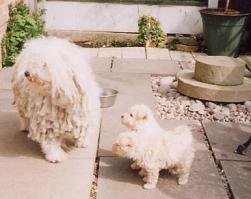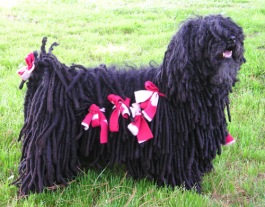The Hungarian Puli: Compact, vigorous and alert, the Puli is a tough-as-nails herding dog, able to perform its duties across any terrain. The Puli coat is wavy or curly and naturally clumps together into wooly “cords,” which protects them from harsh weather. Coat colors include black, gray and white. Today, the Puli is often seen in the show ring, as well as in the herding, obedience, agility, tracking and therapy dog arenas.
A Look Back
 As the ancient sheepdog of Hungary, the Puli has been herding flocks for Hungarian Shepherds for more than 1,000 years. Puli ancestors were brought into the country by the Magyars and were similar to the Kuvasz and Komondor at the time. The Puli was nearly lost in the 17th century due to interbreeding, but the breed was revived in 1912, leading to the first Puli standard in 1915.
As the ancient sheepdog of Hungary, the Puli has been herding flocks for Hungarian Shepherds for more than 1,000 years. Puli ancestors were brought into the country by the Magyars and were similar to the Kuvasz and Komondor at the time. The Puli was nearly lost in the 17th century due to interbreeding, but the breed was revived in 1912, leading to the first Puli standard in 1915.
Right Breed for You?
 Intelligent and possessing an excellent sense of humor, Pulis retain their “puppy” attitude nearly their entire lives. The breed loves their family and home, and as such, is naturally protective and suspicious of strangers. Although they love the farm, Pulis can thrive in a variety of living situations due to their medium size, but owners must provide daily opportunities for exercise. The corded coat takes time to maintain – thorough drying after bath time is especially important to prevent mildewed cords.
Intelligent and possessing an excellent sense of humor, Pulis retain their “puppy” attitude nearly their entire lives. The breed loves their family and home, and as such, is naturally protective and suspicious of strangers. Although they love the farm, Pulis can thrive in a variety of living situations due to their medium size, but owners must provide daily opportunities for exercise. The corded coat takes time to maintain – thorough drying after bath time is especially important to prevent mildewed cords.
Appearance
The Puli is a solid colored dog that is usually black. Other less common coat colors are white, gray, or cream. A variety of the cream-coated dogs have black masks. The white Pulik are often blue-eyed and called Roxies. The breed standard is for females about 16.5 inches (42 cm) at the withers, and 17 inches for males. Females weigh 23-25 pounds, males slightly more. The coat of some Puli dogs can be different, thinner or thicker cords, either flat or round, depending on the texture of the coat and the balance of undercoat to outer coat.The coat is the result of a controlled matting process. Thin rope-like corded coats are desired and the grooming should control the coat towards the forming of thinner ropes. The Puli’s coat needs considerable grooming to keep its cords clean, neat, and attractive. With age the coat can become quite long, even reaching the ground.Alternatively, the coat can be trimmed short regularly for easy maintenance, although the corded coat is what attracts many people to the breed. Contrary to some beliefs, the coat of a healthy puli will grow out again after trimming. This breed has little to no shedding.
Temperament
 Puli are reasonably intelligent, agile dogs. Despite their bulky appearance and very thick coat they are very fast, agile and able to change directions instantly and are obedient enough to train for athletic competition. They are devoted and form close bonds with their owners.
Puli are reasonably intelligent, agile dogs. Despite their bulky appearance and very thick coat they are very fast, agile and able to change directions instantly and are obedient enough to train for athletic competition. They are devoted and form close bonds with their owners.
The breed is intelligent and can do well in obedience training if begun early. Traditionally, the Puli dog breed was used both as a livestock guarding dog, and herding dog as well. They make very good guard dogs, as they are very protective of their master and territory. The Puli is sensitive, fun loving, courageous, but also at times tough and headstrong.
They are loyal to their owners and wary of strangers. They are highly active and keep a playful, puppy-like behavior their entire life. They need a lot of exercise and free space, preferably outdoors. They can be trained and housebroken, but Puli are generally not very well suited to be city or indoor pets. When restricted to closed spaces for long times, they grow restless and might develop unwanted personality traits, such as becoming hyperactive or, instead, increasingly aloof and lazy.
 As a working dog, the Puli is very obedient, focused and determined when assigned a task. Some of them are used as police dogs. As a livestock guarding dog they are fiercely protective of their territory and flock, and, despite their relatively small size, will fearlessly try to scare and drive any intruder away, however they very rarely inflict any real injuries.
As a working dog, the Puli is very obedient, focused and determined when assigned a task. Some of them are used as police dogs. As a livestock guarding dog they are fiercely protective of their territory and flock, and, despite their relatively small size, will fearlessly try to scare and drive any intruder away, however they very rarely inflict any real injuries.
As a family dog, they make good security dogs and faithful family guardians. They can be very friendly and playful, even in old age. They regard their family as their flock, and will keep their distance until they are sure a stranger is not a threat. When annoyed, they may attack without warning, so a considerable distance may be advisable for strangers. They can be extremely independent and obstinate, and only accept strong willed individuals as master.
Activities
Puli can compete in dog agility trials, obedience, Rally obedience, showmanship, flyball, tracking, and herding events. Herding instincts and trainability can be measured at noncompetitive herding tests. Puli exhibiting basic herding instincts can be trained to compete in herding trials.
Training
Puli are valued for their energy and determination, which is a result of their sheepdog history. Every Puli is a natural shepherd, and instinctively knows how to herd a flock of sheep or livestock, even if they have been raised as a family dog and never been trained to do it. It is advisable to start training the Puli early, especially obedience. They are very independent, strong-willed and hard to train in adulthood.












1 comment
Comments feed for this article
October 29, 2012 at 2:04 PM
alalalla
i love puli dogs but they are a rare breed and could run you thousand bucks